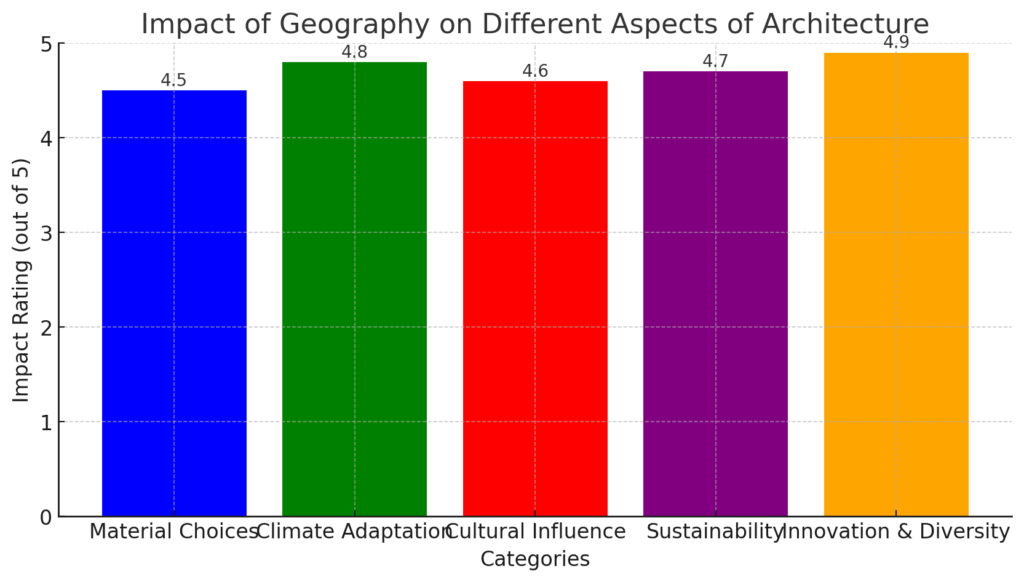In the realm of architecture, geography plays a pivotal role in influencing the design, construction, and aesthetics of buildings. From the towering skyscrapers of urban jungles to the quaint cottages nestled in picturesque landscapes, the impact of geographical surroundings on architectural marvels cannot be overstated. In this article, we’ll delve into How Does Geography Affect Architecture, uncovering the ways in which the natural world shapes our built environment.
Geography significantly shapes architecture by influencing building styles, materials, and sustainability choices. From the design of desert adobe houses to the use of local resources in coastal structures, the impact of geography on architecture is profound and diverse.
Geography, an integral aspect of our world, significantly impacts various facets of life, including architecture. We delve into the nuances of geographic information systems, understanding the intersection between geography and architecture offers a fascinating exploration of how our surroundings shape the structures we inhabit and create.
How Does Geography Affect Architecture?
Geography profoundly influences architecture, impacting everything from the materials used to the overall design and construction of buildings. This relationship is a fascinating blend of environmental, cultural, and social elements, each playing a vital role in how buildings are conceptualized and built.
| Aspect | Description |
|---|---|
| Material Choices | Local geography determines the availability of construction materials, influencing architectural design. |
| Climate Adaptation | Architectural styles evolve to accommodate local climate conditions. |
| Cultural Influence | Geographic features shape the cultural identity reflected in architecture. |
| Sustainability | Geography drives sustainable architectural practices and resource utilization. |
| Innovation & Diversity | Varied geographical landscapes lead to diverse and innovative architectural designs. |

The visualization above represents the impact of geography on various aspects of architecture. Each category, such as Material Choices, Climate Adaptation, Cultural Influence, Sustainability, and Innovation & Diversity, is rated on a scale of 5 to illustrate the significance of geographical factors in shaping architectural designs and practices. This visual aid enhances the understanding of how geography interplays with architectural elements, highlighting the areas where its influence is most pronounced.
Influence of Local Materials and Terrain
Geography primarily influences architecture through the availability of materials and the nature of the terrain. In regions abundant in natural resources like stone, clay, or timber, these materials naturally find their way into local architectural styles.
This link between local resources and construction practices not only dictates the aesthetic of buildings but also their functionality and durability.
Soil type can dictate the foundation and structural design of buildings. Certain soil types, like clay or sandy soils, may require specialized foundations to prevent sinking or shifting. This aspect of geography directly influences the construction methods and materials used.
For instance, timber, prevalent in forest-rich areas, leads to the development of wooden architecture, which is both sustainable and adaptable to various designs. This connection between geography and material choice is evident in how different branches of human geography influence regional architectural styles.
Climate Considerations in Architectural Design
Another vital aspect where geography affects architecture is climate adaptation. Buildings in different geographical locations are designed to withstand local weather patterns.
For example, in tropical climates, architecture focuses on maximizing air circulation and shade, whereas in colder regions, the emphasis is on insulation and heat retention. This climatic adaptation is not only a matter of comfort but also of energy efficiency and sustainability.
Understanding these geographical nuances is crucial, similar to comprehending the sub-branches of physical geography, each playing a unique role in shaping our environment.
Cultural Reflections in Architecture
Architecture is a reflection of culture, and geography significantly influences cultural development. The geographic setting of a region shapes its history, traditions, and way of life, which in turn is mirrored in its architectural styles.
For example, the architecture of a coastal city might prominently feature elements that reflect its maritime heritage.
This cultural aspect is as important in architecture as understanding the 6 essential elements of geography is in comprehending the world around us.
Sustainable Practices Driven by Geography
Sustainability in architecture is closely linked to geographical factors. The use of local materials not only reduces the carbon footprint associated with transportation but also ensures that the buildings are suited to the local environment.
Moreover, sustainable architectural practices often stem from traditional methods that have evolved over centuries, adapting to the local geography.
This approach to sustainability is akin to understanding the delicate balance between geology and geography, where each plays a critical role in shaping the earth’s landscape and our interaction with it.
Geography’s Role in Architectural Diversity and Innovation
Diverse geographical landscapes foster a variety of architectural styles and innovations. From the soaring skyscrapers of urban landscapes to the quaint cottages of rural areas, each structure is a testament to the geographical context in which it is built.
The challenges posed by different terrains, such as mountains, plains, or coastal areas, often lead to innovative architectural solutions.
This diversity is as enriching to the field of architecture as the applications of remote sensing in geography are to understanding and managing our planet.
Conclusion: The Interplay of Geography and Architecture
In summary, the intricate relationship between geography and architecture is a dance of adaptation, cultural expression, sustainability, and innovation. Just as geography shapes our way of life, it molds the architectural landscapes we see around us. By understanding this connection, we gain deeper insights into both the art of architecture and the science of geography.
FAQs: How Does Geography Affect Architecture?
How does geography influence the choice of building materials?
Geography influences the availability of materials, which in turn affects the sustainability and resilience of architectural designs.
Are there any architectural styles unique to certain geographical regions?
Yes, many architectural styles are closely tied to specific regions, reflecting the culture, climate, and traditions of the area.
How does urban geography differ from rural geography in terms of architecture?
Urban areas prioritize vertical, modern designs, while rural areas emphasize simplicity and integration with the natural environment.
What role does geography play in the sustainability of architectural designs?
Geography determines the availability of sustainable building materials and influences architectural responses to natural disasters.
